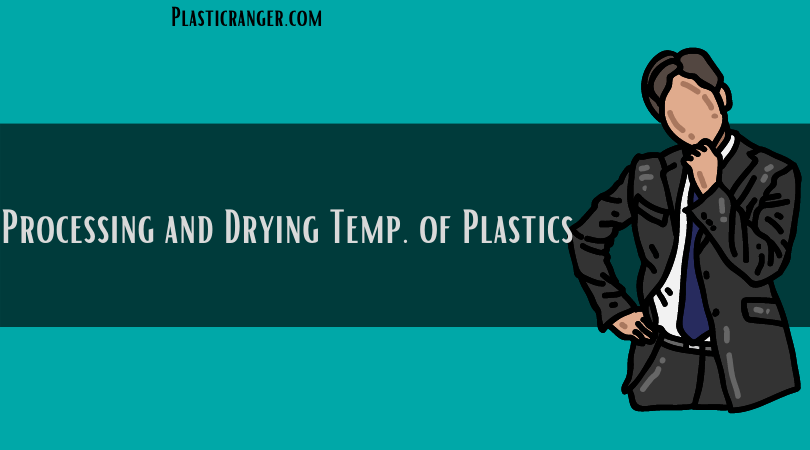All people working in the plastic profession should know that plastic drying while manufacturing is a normal phenomenon. Someone working at a plastic processing factory should clearly know the processing temperature of all plastic material. Let’s dive into our article talking about polymer processing temperature.
The Processing and Drying Temperature of Plastics
| Polymer name | Processing Temp. | Drying Temp. | Hours | BD |
| ABS High | 440-510°F | 190°F | 4 | 42 |
| ABS Med I | 440-510°F | 190°F | 4 | 42 |
| Acetal | 380-420°F | Homo 200 Co 210°F | 1.5 | 40 |
| Acrylic Gen Purpose | 420-485°F | 180°F | 1.5 | 42 |
| Acrylic High Heat | 420-485°F | 180°F | 2.5 | 42 |
| Acrylic High Impact | 420-485°F | 180°F | 2.5 | 42 |
| Nylon 6/6 | 500-560°F | 180°F | 4 | 41 |
| Nylon 6 | 470-530°F | 180°F | 4 | 41 |
| Nylon 6/1 | 460-510°F | 180°F | 4 | 41 |
| Nylon 12 | 400-450°F | 180°F | 4 | 41 |
| Polycarbonate | 540-570°F | 250°F | 3.5 | 40 |
| PET – Bottle | 520-560°F | 340°F | 5 | 52 |
| PBT | 460-490°F | 260°F | 2.5 | 48 |
| PBT 30% G | 460-490°F | |||
| Polyether | 680-720°F | 310°F | 4 | 52 |
| Polyethylene | 340-440°F | |||
| PPO | 480-580°F | 210°F | 2.5 | 49 |
| Polypropylene | 420-520°F | 167˚F | 2 | |
| Polystyrene | 400-480°F | 176 F | 2.5-3 (only if required) | |
| PVC Rigid | 320-420 | |||
| PVC Semi | 320-420 | |||
| PVC Flexi | 320-420 | |||
| SAN | 400-500 | 180 | 3 | 40 |
Engaging Read – Melting Point of Plastics | The Ultimate Guide
The Importance of Processing and Drying

As we all know, processing material should be done perfectly to produce quality products.
Inaccurate processing can lead to the production of faulty and deficient products and can also sometimes cause damage to the mold and the molding machine.
The importance of drying temperature is also an essential part of the process, as too much moisture can cause several processing problems.
Most plastics exhibit some level of polarity and absorb some moisture from the air. The impact moisture will have depends on the polymer and its applications.
Before resin preparation for injection or production in injection molding, the material should be adequately dried according to the manufacturer’s recommendations. By not doing that, a manufacturer is risking the quality of the part.
Common issues are brittleness, bubbles, sink marks, irregular moldings, and lower mechanical properties.
Adequate drying can also significantly lower the risk of hydrolysis and part failure. Hydrolysis is a chemical reaction in polymers that ruptures the covalent bonds in its chain, reducing its mechanical properties.
However, using a drying system cannot continuously improve the quality and consistency of the injection molding process.
On the shop floor, consistently monitoring the dew point and moisture content of resins is necessary to ensure they meet manufacturers’ dryness recommendations.
Factors Affecting Processing and Drying Temp of Plastics
Temperature control is paramount in the plastic manufacturing process, directly impacting both the quality and the efficiency of the final product.
Several complex factors affect the processing and drying temperature, warranting meticulous attention.
First, ambient conditions in the manufacturing environment play a pivotal role. Variations in room temperature, humidity, and airflow can drastically alter the effectiveness of drying and processing temperature settings.
Since plastics are hygroscopic, even subtle shifts in relative humidity can impede the drying process, requiring temperature adjustment.
Second, the material thickness significantly influences temperature needs.
Thicker materials necessitate prolonged exposure to heat, often requiring higher processing temperatures or longer dwell times to achieve uniform thermal distribution.
This not only impacts the quality but also the energy usage and throughput. Third, machine types contribute to temperature regulation.
Different machines, injection molding machines or extruders, have distinct thermal dynamics and operational efficiency.
The material’s residency time within the machine, the shear forces generated, and the machine’s thermal inefficiencies all contribute to temperature fluctuations.
High-quality machines often have better thermal regulation features, which is crucial for materials with narrow processing windows.
Finally, the type of plastic material itself dictates temperature needs.
For example, polyethylene might process effectively at a lower temperature, but polycarbonate might require significantly higher settings.
Considering these multifaceted influences is essential for achieving optimal outcomes. Advanced solutions such as machine learning algorithms and IoT-based sensors are emerging to help manufacturers adapt dynamically to these variables, ensuring quality and efficiency.
By acknowledging and adapting to these factors, manufacturers can operate at the pinnacle of precision and efficacy, underlining the significance of temperature control in the plastic industry.
Final Thoughts
That’s all I wanted to say about the processing and drying temperature of plastics. The data published in the article is well researched and comes from reliable sources. However, the data is shared just for information purposes. Consulting your material supplier about the processing and drying temperature of the material you want to work with is the best way to go.
Kindly share your thoughts and question in the comment box.
Have a wonderful day.
Quick Navigation


Thank you very much for your analysis. Was looking for the drying temp of PET, and got my answer.
Thank you very much for your analysis.
My pleasure.